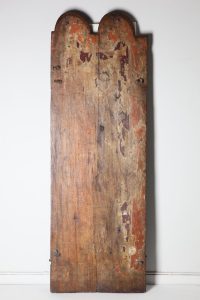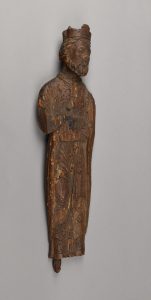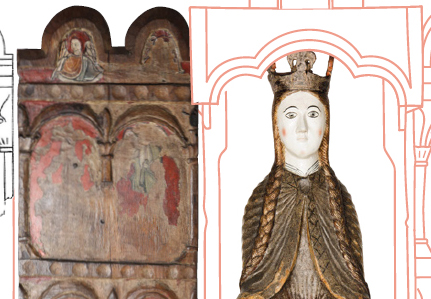

This enthroned Virgin is one of the earliest preserved Marian sculptures in Norway and can be dated to the second half of the twelfth century. Mary sits frontally on a folding throne decorated with animal heads and addresses the onlooker with a poignant gaze. Her skin is whitish, her cheeks are reddish, and her eyes and eyebrows are dark lined. She wears a four-pointed fleur-de-lys crown. Her hair is plaited into two braids that fall over her shoulders. The same direction is marked by her cloak, which is fastened with a brooch and covers her now-lost arms in parallel folds, revealing its inner lining. Her robe is held by a decorated belt and falls over her knees in vertical pleats. Dark, pointed shoes peek outward from under it. Her hair, robe and cloak were originally covered in imitation gold (silver coating with a glaze), but the high proportion of silver made its tone greyish. A now-lost Christ Child probably sat on her lap in a central position, making the sculpture into a classical Sedes Sapientiae (‘Throne of Wisdom’).
The motif of parallel pleats falling to the floor between the shoes was particularly common in Northern French and Rhenish-Mosan sculpture around the middle of the twelfth century, as is exemplified by a Virgin and Child from the priory church of Saint-Martin-des-Champs in Paris, known as ‘Notre-Dame de la Carole’. In the same manner, the braids, as a symbol of Mary’s virginity, appear first in the mentioned areas around the same time and are found in English and Scandinavian sculptures slightly later. It cannot be established with certainty if the Virgin from Urnes was produced in Scandinavia or imported from one of the leading artistic centres of Europe. The limited depth of the figure indicates that it sat in a so-called ‘tabernacle shrines’, shrine, parts of which are preserved.


Tabernacle shrines consists of an enclosure containing a sculpture that can be shut by means of movable wings and, when opened, provided the figure with a narrative context. Preserved elements from the shrine are the left inner wing and fragments of the architectural crown. Together with several fragmentary Marian shrines found in Italy and Sweden (for example from Appuna, now in Stockholm, Statens historiska museum, inv. no. 7890:1), the fragments from Urnes offer the earliest tangible evidence for the spread of tabernacle shrines in medieval Europe.
The wing is composed of two registers that are both closed off by strips decorated with medallions. Round arches divide each register into two sections. The upper register, on the right side, contains remnants of a painted figure in a green robe against a red background. The other three sections have preserved no vestiges of figurative painting, but parts of the red background have survived. Round holes in the two lower sections, as well as in the top left one, may indicate the attachment of relief figures. The wing ends in two round lunettes, the left one of which features a painted angel holding an empty banderole. Remnants of a comparable angel figure are preserved in the right lunette. The exterior of the wing shows a painted face of a beardless man in semi-profile and the fragment of a raised hand. It cannot be established with certainty whether this is an angel or a saint.

Martin Blindheim convincingly ascertained that the shrine fragment, which was listed in museum protocols as originating from Røldal, in fact belonged to the stave church at Urnes. In 1953, during a visit there, he discovered an identically shaped, badly weathered and now-lost fragment of an outer shrine wing. Blindheim also assumed that the relief of a standing king that entered the Bergen collection from an unknown church during the late nineteenth or early twentieth century originally belonged to the same tabernacle shrine. Recent investigations have shown that the figure likely represents one of the Three Magi that commonly appeared on the insides of the wings of tabernacle shrines, at the bottom left. The king may well have filled the lower section of the now-lost outer wing.
Norway (?), 1150-1200
From Urnes (Luster, Sogn), in the museum since 1859 (Virgin and Child); before 1900 (wing); from an unknown church around 1900 (king)
Softwood, remnants of painting and polychromy
H 119 x W 50 x D 24 cm (Virgin and Child)
H 130 x W 45 x D 2.5 cm (wing)
H 51 x W 13 x D 5.5 cm (king)
Inv. nos. MA 46 (Virgin and Child), MA 297b (wing), MA 331 (king)
